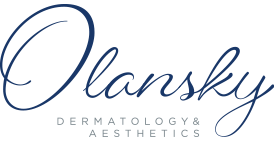When you think of Botox, chances are cosmetic applications come to mind. Indeed, here at Olansky Dermatology, we offer Botox to smooth facial wrinkles such as crow’s feet and frown lines. Yet, Botox has a far-reaching history, and it’s still used to treat a number of different medical issues today. Here’s a look into the fascinating origin story of Botox.
When Was Botox First Used?
The Botox drug is made from a toxin that the bacterium Clostridium botulinum produces. It works by weakening or paralyzing specific muscles or blocking nerves. It’s the same toxin that could lead to food poisoning if ingested, and in fact, that’s how Botox’s story begins.
Botulinum toxin was first discovered in 1897, after a group of Belgian musicians fell sick when eating the same smoked ham after performing at a funeral. Following such an extreme event, the ham was sent for analysis to a professor of bacteriology, Emile van Ermengem, at the University of Ghent. Dr. van Ermengem originally discovered the bacteria, but it was only later isolated and purified by US scientists during World War II. Throughout the mid 1900s, the bacteria was further studied in the US, and finally, D.B. Drachman demonstrated the toxin’s paralysis effect while conducting animal studies in 1965.
In the 1970s, American ophthalmologist Dr. Alan Scott began to investigate the toxin as a possible treatment for eye impairments. In 1978, he injected the paralytic into a patient for the first time, in an attempt to treat the eye muscles after surgery for retinal detachment. This experiment was successful, and paved the way for other patients to receive it, including those who suffered from strabismus, or misalignment of the eyes. Dr. Scott’s groundbreaking research led him to become known as the “Father of Botox.”
The Evolution of Botox
Doctors in other fields heard of Dr. Scott’s injections, and soon began using them for other issues such as jaw-clenching and migraines. But beyond addressing the root problem, these injections also came with an unexpected benefit: patients soon found that the fine lines around their eyes were also smoother afterwards.
The FDA originally approved Scott’s drug, OnabotulinumtoxinA, for therapeutic use in 1989. In addition to treating strabismus, it was also used for blepharospasm, a condition in which the eyes shut tight involuntarily. He sold the rights to the drug in 1991, and the new distributor, Allergan, rebranded to Botox the year afterwards.
Throughout the 1990s, Botox became known as a powerful tool for helping people maintain a more youthful appearance. Doctors became increasingly skilled at using it for cosmetic purposes, and by 2002, the drug received FDA approval for cosmetic applications, including treating frown lines, crow’s feet, and forehead lines.
Today, Botox remains the only neurotoxin with FDA approval for various cosmetic applications. It continues to be used to treat eye conditions, as well as those that cause muscle contractions, chronic migraines, overactive bladder, and severe underarm sweating. Botox can also be used to strategically relax muscles in the face for wrinkle reduction, brow lifting, jawline slimming, and more. Most recently, it may even be linked to reducing anxiety.
If you’re interested in finding out what Botox injections could do for you, turn to Olansky Dermatology. We’ll work to identify how the unique cosmetic capabilities of Botox can best meet your needs. Call (404) 355-5484 or connect with us online to schedule an appointment.


